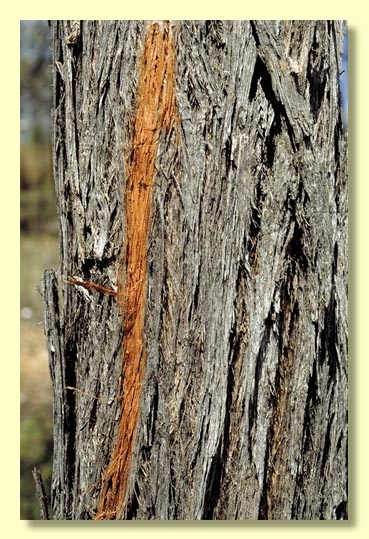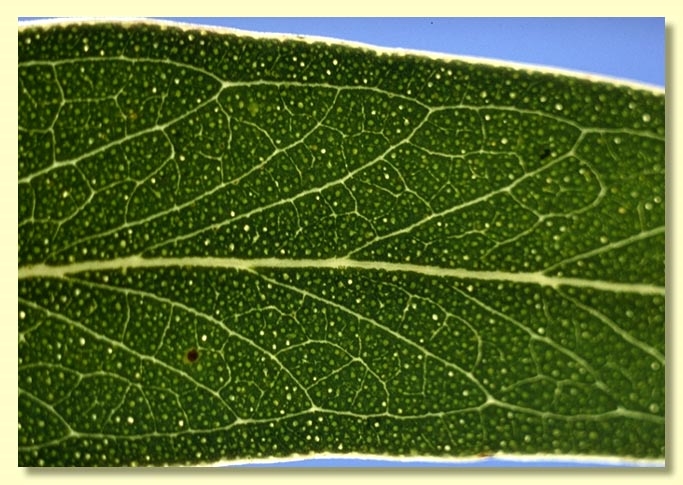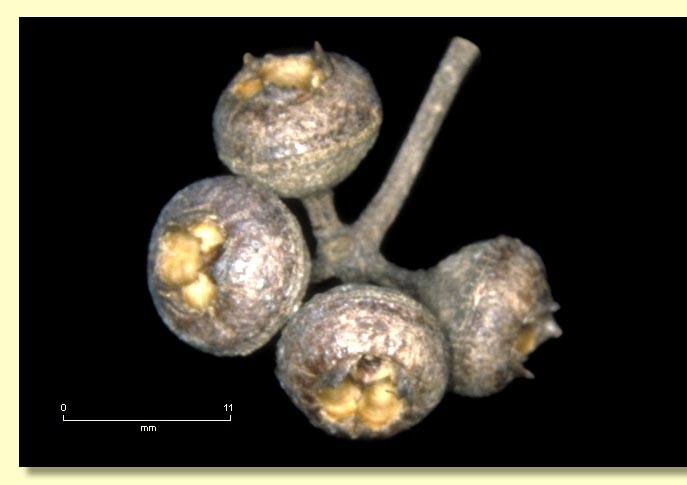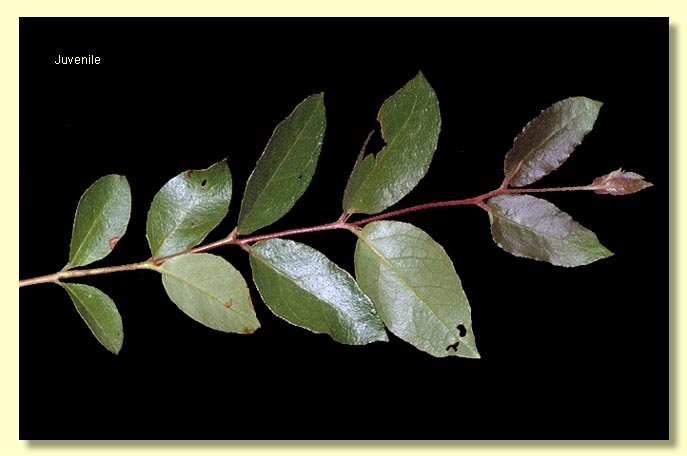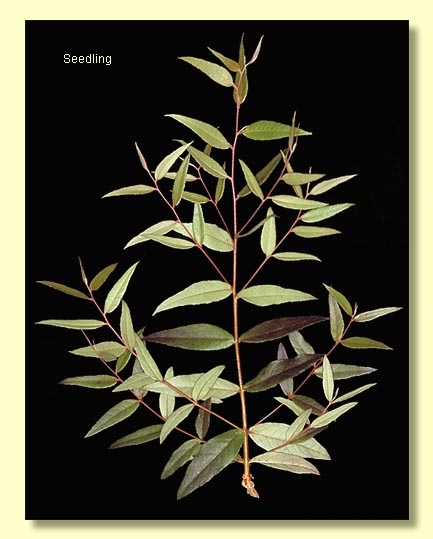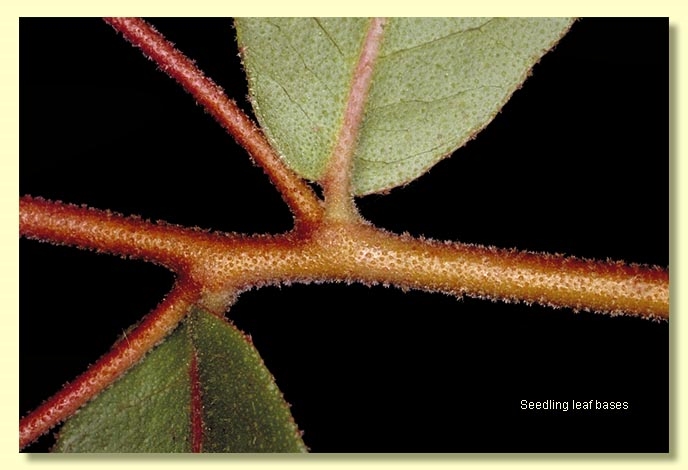Euclid - Online edition
Eucalyptus macrorhyncha subsp. macrorhyncha
Classification
Eucalyptus | Eucalyptus | Capillulus | Pachyphloius
Nomenclature
Eucalyptus macrorhyncha F.Muell. ex Benth., Fl. Austral. 3: 207 (1867) subsp. macrorhyncha.
T: Macalister River, Vic., F.Mueller; syn: MEL; near Mt Ligar, Vic., Jan. 1863, F.Mueller; syn: MEL; Avon R., Vic., Mar. 1854, F.Mueller; syn: K, MEL; Newfield, Melbourne, Vic., 9 May 1856, F.Adamson 471; syn: K.
Eucalyptus macrorhyncha var. minor Blakely, Key Eucalypts 184 (1934). T: Bumble Ra., NSW, Apr. 1932, W.F.Blakely s.n.; syn: NSW; Canowindra, NSW, 13 July 1931, M.Dwyer; syn: NSW; Pilliga State Forest, NSW, Oct. 1911, E.H.F.Swain; syn: NSW; Wolongawah, NSW, 21 Apr. 1932, W.A.W. de Beuzeville 484, 486; syn: NSW; Wolongawah, NSW, 18 Sept. 1916, W.A.W. de Beuzeville s.n.; syn: NSW; Tumut, NSW, 1895, J.H.Maiden s.n.; syn: NSW; Tumut, NSW, Oct. 1899, W.W.Froggatt s.n.; syn: NSW; Tumut, NSW, 19 May 1927, E.Cheel s.n.; syn: NSW.
[Eucalyptus scyphoidea Naudin ex Maiden, Proc. Linn. Soc. New South Wales 28: 899 (1904), nom. inval. - nom. nud. T: cultivated at Villa Thuret, 1889, C.Naudin s.n.; (P).]
T: Macalister River, Vic., F.Mueller; syn: MEL; near Mt Ligar, Vic., Jan. 1863, F.Mueller; syn: MEL; Avon R., Vic., Mar. 1854, F.Mueller; syn: K, MEL; Newfield, Melbourne, Vic., 9 May 1856, F.Adamson 471; syn: K.
Eucalyptus macrorhyncha var. minor Blakely, Key Eucalypts 184 (1934). T: Bumble Ra., NSW, Apr. 1932, W.F.Blakely s.n.; syn: NSW; Canowindra, NSW, 13 July 1931, M.Dwyer; syn: NSW; Pilliga State Forest, NSW, Oct. 1911, E.H.F.Swain; syn: NSW; Wolongawah, NSW, 21 Apr. 1932, W.A.W. de Beuzeville 484, 486; syn: NSW; Wolongawah, NSW, 18 Sept. 1916, W.A.W. de Beuzeville s.n.; syn: NSW; Tumut, NSW, 1895, J.H.Maiden s.n.; syn: NSW; Tumut, NSW, Oct. 1899, W.W.Froggatt s.n.; syn: NSW; Tumut, NSW, 19 May 1927, E.Cheel s.n.; syn: NSW.
[Eucalyptus scyphoidea Naudin ex Maiden, Proc. Linn. Soc. New South Wales 28: 899 (1904), nom. inval. - nom. nud. T: cultivated at Villa Thuret, 1889, C.Naudin s.n.; (P).]
Description
Tree to 35 m tall. Forming a lignotuber.
Bark rough to small branches, stringy, often deeply furrowed, grey or grey-brown or red-brown.
Juvenile growth (coppice or field seedlings to 50 cm): stem rounded in cross-section, scabrid at first; juvenile leaves sessile to shortly petiolate at first, opposite for few pairs then alternate, petiolate, ovate to elliptical, 2.5–10.5 cm long, 2–5.2 cm wide, margin entire or irregular, base rounded, truncate or tapering to petiole, green to blue-green; scabrid on stem, petiole and lamina for 10–14 nodes in seedlings, but on fewer nodes in coppice growth.
Adult leaves alternate, petiole 0.7–2 cm long; blade lanceolate to falcate, 7.5–14 cm long, 1.2–3.8 cm wide, base usually oblique, concolorous, glossy or dull, green, side-veins at an acute or wider angle to midrib, sparsely to moderately reticulate, intramarginal vein parallel to and well removed from margin, oil glands island.
Inflorescence usually axillary unbranched, sometimes terminal panicles, peduncles 0.7–1.8 cm long, buds in umbels of 7, 9 or 11, pedicels (0.2)0.4–0.6 cm long. Mature buds diamond-shaped, 0.5–0.9 cm long, 0.4–0.5 cm wide, green to yellow, scar absent, operculum beaked, stamens irregularly flexed, anthers reniform to cordate, versatile, dorsifixed, dehiscing by confluent slits (usually), style long, stigma tapered, locules 3 or 4, the placentae each with 2 vertical ovule rows. Flowers white.
Fruit on pedicels (0.1)0.2–0.5 cm long, hemispherical or truncate-globose, 0.3–0.7 cm long, 0.6–1.2 cm wide, disc broad and prominently raised convex or oblique, valves 3 or 4, strongly exserted.
Seeds black or brown, 1.5–3 mm long, pyramidal or obliquely pyramidal, dorsal surface smooth, hilum terminal.
Cultivated seedlings (measured at ca node 10): cotyledons reniform to orbicular; stems rounded in cross-section, densely stellate-hairy; leaves always petiolate, opposite for 4 or 5 nodes then alternate, ovate-lanceolate, 4.5–9 cm long, 1.5–5 cm wide, base rounded to tapering, margin more or less entire, discolorous, glossy, darker green above, stellate-hairy on upper and lower surfaces.
Bark rough to small branches, stringy, often deeply furrowed, grey or grey-brown or red-brown.
Juvenile growth (coppice or field seedlings to 50 cm): stem rounded in cross-section, scabrid at first; juvenile leaves sessile to shortly petiolate at first, opposite for few pairs then alternate, petiolate, ovate to elliptical, 2.5–10.5 cm long, 2–5.2 cm wide, margin entire or irregular, base rounded, truncate or tapering to petiole, green to blue-green; scabrid on stem, petiole and lamina for 10–14 nodes in seedlings, but on fewer nodes in coppice growth.
Adult leaves alternate, petiole 0.7–2 cm long; blade lanceolate to falcate, 7.5–14 cm long, 1.2–3.8 cm wide, base usually oblique, concolorous, glossy or dull, green, side-veins at an acute or wider angle to midrib, sparsely to moderately reticulate, intramarginal vein parallel to and well removed from margin, oil glands island.
Inflorescence usually axillary unbranched, sometimes terminal panicles, peduncles 0.7–1.8 cm long, buds in umbels of 7, 9 or 11, pedicels (0.2)0.4–0.6 cm long. Mature buds diamond-shaped, 0.5–0.9 cm long, 0.4–0.5 cm wide, green to yellow, scar absent, operculum beaked, stamens irregularly flexed, anthers reniform to cordate, versatile, dorsifixed, dehiscing by confluent slits (usually), style long, stigma tapered, locules 3 or 4, the placentae each with 2 vertical ovule rows. Flowers white.
Fruit on pedicels (0.1)0.2–0.5 cm long, hemispherical or truncate-globose, 0.3–0.7 cm long, 0.6–1.2 cm wide, disc broad and prominently raised convex or oblique, valves 3 or 4, strongly exserted.
Seeds black or brown, 1.5–3 mm long, pyramidal or obliquely pyramidal, dorsal surface smooth, hilum terminal.
Cultivated seedlings (measured at ca node 10): cotyledons reniform to orbicular; stems rounded in cross-section, densely stellate-hairy; leaves always petiolate, opposite for 4 or 5 nodes then alternate, ovate-lanceolate, 4.5–9 cm long, 1.5–5 cm wide, base rounded to tapering, margin more or less entire, discolorous, glossy, darker green above, stellate-hairy on upper and lower surfaces.
Flowering Time
Flowering has been recorded in February, March, April, June and July.
Notes
Eucalyptus macrorhyncha is a medium-sized stringybark tree species of widespread distribution on relatively dry, poor soils of hills and tablelands from Stawell in western Victoria, east to the upper Genoa River and north through the tablelands and western slopes of New South Wales as far as Warialda with some outliers in hills in the South Western Plains, e.g. Mt Bingar, north-east of Griffith and a quite isolated occurrence in the Clare district of South Australia. E. macrorhyncha is fully rough-barked, with a green to blue-green crown, distinctly pedicellate buds with a conical to strongly beaked operculum and large almost spherical fruit including the massive domed disc, with prominent valves. Juvenile growth is scabrid only on the lower leaves and stems.
There are two subspecies:
E. macrorhyncha subsp. macrorhyncha
Widely distributed, from Clare to Warialda. Subsp. macrorhyncha has buds with a prominently beaked operculum and fruit to 0.6–1.2 cm wide. Valves are prominent but not as extravagantly exserted as in subsp. cannonii. Plants in the Dubbo, Warrumbungles and Bundarra areas have only shortly beaked or conical opercula, as do the isolated plants on the Cocoparra Range. Elsewhere such opercula are uncommon.
E. macrorhyncha subsp. cannonii
Restricted to the Capertee, Ilford and Rylstone areas of New South Wales, having coarser and larger buds, and fruit to 1–1.6 cm wide, with more oblique disc and strongly exserted valves compared with subsp. macrorhyncha.
Eucalyptus macrorhyncha is very distinctive amongst the stringybarks because of the obvious pedicels, prominent disc and mainly inland distribution. Only on the North-western Slopes of New South Wales does identification become problematic, around Bundarra and Barraba, where the stringybarks could be either E. laevopinea or E. macrorhyncha subsp. macrorhyncha.
Eucalyptus machrorhyncha subsp. cannonii (as E. cannonii) is listed as "Vulnerable" under the Australian Government Environment Protection and Biodiversity Conservation Act 1999 (EPBC Act). Further information may be found at this web address:
http://www.environment.gov.au/cgi-bin/sprat/public/sprat.pl
MORE ABOUT STRINGYBARKS
There are two subspecies:
E. macrorhyncha subsp. macrorhyncha
Widely distributed, from Clare to Warialda. Subsp. macrorhyncha has buds with a prominently beaked operculum and fruit to 0.6–1.2 cm wide. Valves are prominent but not as extravagantly exserted as in subsp. cannonii. Plants in the Dubbo, Warrumbungles and Bundarra areas have only shortly beaked or conical opercula, as do the isolated plants on the Cocoparra Range. Elsewhere such opercula are uncommon.
E. macrorhyncha subsp. cannonii
Restricted to the Capertee, Ilford and Rylstone areas of New South Wales, having coarser and larger buds, and fruit to 1–1.6 cm wide, with more oblique disc and strongly exserted valves compared with subsp. macrorhyncha.
Eucalyptus macrorhyncha is very distinctive amongst the stringybarks because of the obvious pedicels, prominent disc and mainly inland distribution. Only on the North-western Slopes of New South Wales does identification become problematic, around Bundarra and Barraba, where the stringybarks could be either E. laevopinea or E. macrorhyncha subsp. macrorhyncha.
Eucalyptus machrorhyncha subsp. cannonii (as E. cannonii) is listed as "Vulnerable" under the Australian Government Environment Protection and Biodiversity Conservation Act 1999 (EPBC Act). Further information may be found at this web address:
http://www.environment.gov.au/cgi-bin/sprat/public/sprat.pl
MORE ABOUT STRINGYBARKS
Origin of Name
Eucalyptus macrorhyncha: Greek macro, large, long and rhynchos, nose, referring to the opercula.
Copyright © CANBR 2020, all rights reserved.

Web edition hosted at https://apps.lucidcentral.org/euclid

